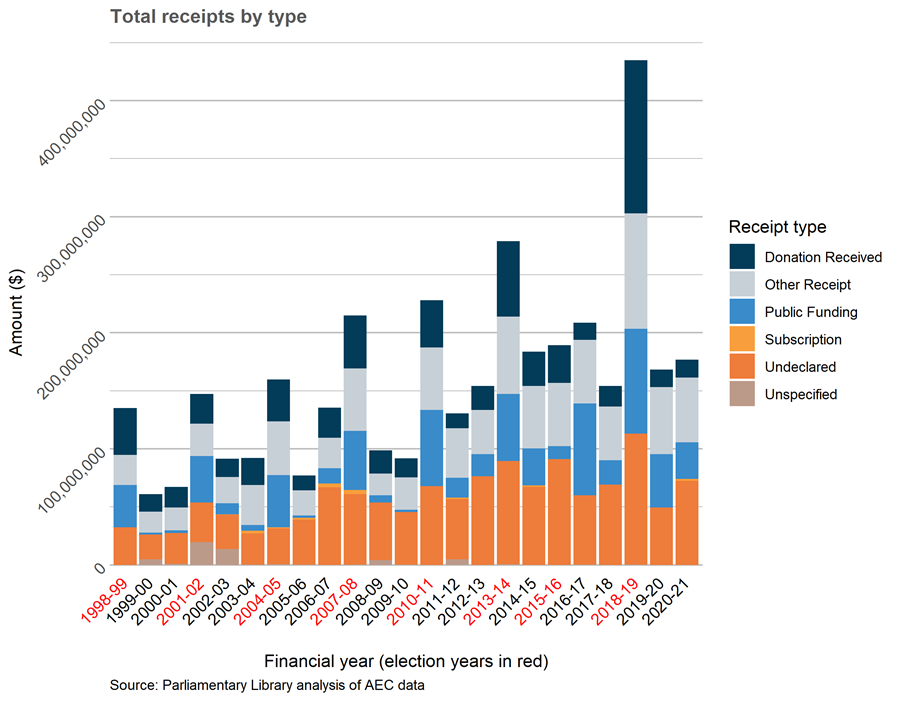Posted 18/05/2022 by Damon Muller
Federal elections are expensive. The Australian Electoral Commission (AEC) reported that the 2019 federal election cost around $303 million to run (excluding public funding, which is discussed below). This included about $103 million was for staffing (with an additional $38 million on labour hire), $22.5 million on advertising and $32 million on post and freight.
The likely cost to the AEC, and thus the federal budget, of the 2022 federal election is difficult to currently estimate. The AEC received total appropriations of around $458 million in 2021–22 and is budgeted to receive around $241 million in 2022–23. Most of the election costs will be spread over the two financial years, but the amount also includes standard operating costs.
In contrast to 2019, the 2022 federal election will occur during the COVID-19 pandemic. In its submission to the parliamentary Joint Standing Committee on Electoral Matters inquiry into elections during emergency situations, the AEC stated that the Eden-Monaro by-election, which was conducted after the pandemic began, cost about twice the normal average. In October 2021 the AEC estimated that the 2022 election would cost around $400 million, roughly a $100 million increase on 2019, but there remained significant uncertainty about how much extra COVID measures would cost.
Public funding
One of the largest total election costs is the public funding provided to political candidates. Every candidate or party that receives at least 4% of the vote in the House of Representatives and the Senate, receives $2.914 for every first preference vote. With 17.2 million people enrolled, that means the public funding bill might be up to $100 million (practically however, not every enrolled person will vote for a candidate that passed the 4% threshold). In 2019 the total public funding bill was $68.6 million, with the Liberal and Labor Parties claiming $27.6 million and $24.7 million, respectively. Parties and candidates can only claim to cover actual campaign expenditure, although in 2019 most claimed the full amount they were entitled to.
Party and candidate spending
In addition to the AEC’s spending, parties and candidates also spend money on election campaigns, although exactly how much and where that money comes from remains unclear. Section 309 of the Commonwealth Electoral Act 1918 requires non-party affiliated candidates to disclose their electoral expenditure after each election, but parties have no similar disclosure requirements.
Parties are required to submit annual financial returns to the AEC stating how much they receive and spend each financial year; however, there is no requirement to break down or itemise the spending. While it is impossible to determine how much parties spend on elections, party expenditure substantially increases in election years. In 2018–19 the parties collectively reported spending around $433 million, presumably much of it on the election that was held in May 2019. Note that this does not include spending by associated entities (organisations that are controlled by or affiliated with political parties) or third parties.

Financial disclosure laws require the AEC to publish political party financial returns for the previous financial year at the start of each February. This means that political party spending covering the 2022 federal election will be reported in February 2023, more than eight months after the event.
In the meantime we are reliant on estimates of advertising spending from the media and occasional statements by parties and candidates. One estimate suggests that all parties will spend $500 million on advertising this election, and Clive Palmer has stated that he will spend $70 million on advertising for the United Australia Party, for example.
Social media
One small but significant change in spending transparency since the 2019 election is the operation of Facebook’s Ad Library in Australia, which allows researchers to collate the amount of political advertising spending on Facebook. However, it is likely that social media advertising is only a small component of the total advertising spend of the parties.
Funding source
As with the total amount of election spending undertaken by the parties, the source of political party funding is at least in part also a mystery. Parties and candidates are required to annually report individual donations over $14,500 to the AEC; however, this leaves a lot of funding unaccounted for.

In the financial year covering the 2019 federal election, political parties reported a collective income of around $435 million. Of that, around $131 million (30%) came from declared donations, $90 million from public election funding (21%), $100 million from other income (23%) and the remaining $113 million (26%) undisclosed (likely from donations below the disclosure threshold).
Australia lacks the level of transparency of many other Western democracies when it comes to campaign finance and political parties. A significant proportion of public funding for elections, which may approach $100 million this election, is reported to the AEC, yet is only released to the public as an aggregate figure. Simply put, the source of a large amount of the money parties spend on elections in Australia can be described as a mystery. This lack of transparency can lead to questions of accountability in the broader public.